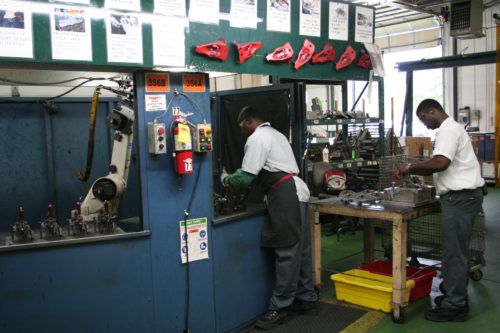 Robotic MIG Welding Services
Robotic MIG Welding Services
Metal Inert Gas (MIG) welding is a gas metal arc welding process common in shops and factories across the country. Robotic MIG welding uses a continuous solid wire electrode, which is fed through the machine using a liner, then out of an electrically charged contact tip. When the tip is heated, the solid wire electrode melts to create the weld and join the two base materials.
MIG welding gets its name because it uses inert gas to protect the weld puddle and the electrode from airborne contaminants, which mitigates the risk of bubbling in the weld pool to create stronger and cleaner welds.
At Clairon Metals, we use innovative robotic MIG welders that can achieve very precise welds to nearly any project specification. Our skilled MIG welders use these robotic weld cells along with custom-designed, pneumatic clamping weld fixtures to guide a weld bead exactly in place every time to the proper width, length and depth of penetration. To ensure the welds are always good we also have the capability to perform Macro Etching on site. Macro etching is an advanced method of verifying weld penetration to the substrate. The part is cut at the weld joint, polished and etched then viewed in a microscope to see the penetration of the weld into the base metal. Robotic Welding vs. Manual Welding.
MIG welding processes may be performed using either robotic or manual techniques. While MIG welding has traditionally been performed by hand, innovations in robotics now offer comprehensive robotic welding solutions. When deciding between a robotic weld vs. a manual weld, consider the following factors:
- Accuracy. Any manual process always runs the risk of human error. Robotic MIG welding mitigates this risk, increases accuracy, and offers more reliable weld repeatability between parts in the same production run.
- Quality. Quality levels in a manual weld may vary, but an automated MIG welding process ensures the weld quality through the use of electronic weld process controllers and quality management software.
- Speed. Speed is perhaps one of the largest benefits of automated MIG welding. Robotic welders can achieve precision welds at a faster pace, which facilitates higher production volumes with shorter lead times.
- Waste. The amount of wasted material in a manual process may differ from weld to weld. A robotic welder uses the same amount of weld material in each process, ensuring less waste and predictable costs.
Top Industries for Robotic MIG Welding
Robotic MIG welding has become a very popular welding technique in use in almost every industry where there is a metal structure or frame as part of the product.
-
Manufacturing
Robotic MIG welding is a critical element in the cost-effective production of all types of consumer products, such as power sports, lawn and garden, HVAC, solar, furniture, and machinery. The repeatability, speed, and cost-efficiency of robotic welding make it the perfect solution for mass production and high-output manufacturing.
Welding has been integral to the aerospace industry since its beginnings due to its effectiveness at creating airtight seals between disparate metal parts. The accuracy and efficiency offered by robotic MIG welding play an integral role in the manufacture of parts and components used in aircraft, spacecraft, and more. -
Automotive
The ability of MIG welding to create solid welds between thin sheets of metal has made it increasingly popular in the automotive industry. Vehicles require thousands of welds, and robotic MIG welding provides a cost-effective method of ensuring high-quality welds throughout the manufacturing process.
-
Construction and Infrastructure
MIG welding is widely used to weld steel components found in the construction of commercial and residential buildings. MIG welding is also used to repair damaged machines and broken tools.
-
Shipping and Marine
The shipping and marine industry routinely uses robotic MIG welding because of the quality and consistency it offers. The speed and quality of MIG welding provide engineers with a process for joining metal that can meet the demands of harsh marine environments.
Robotic MIG Welding From Clairon Metals

Utilizing CAD design and our 18 robotic weld cells, our team of designers, engineers, and fabricators can reliably and repeatedly produce components to exact specifications. Our pre-engineered solutions integrate robots, servo positioners, and arc welding technology to solve any fabrication challenge. These advances, combined with innovative robot welder communication and effective software improvements, are the perfect solutions for any welding demand while maximizing efficiency and productivity.
Robotic MIG welding offers one of the most efficient, cost-effective ways of creating high-quality, consistent welds. Our team at Clairon Metals has advanced equipment, knowledge, and skill to provide the highest-quality precision welding solutions for any application.
To learn more about robotic MIG welding and how Clairon Metals can provide solutions for your fabrication needs, contact us today.





